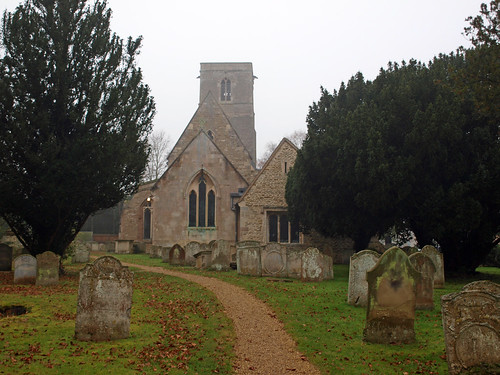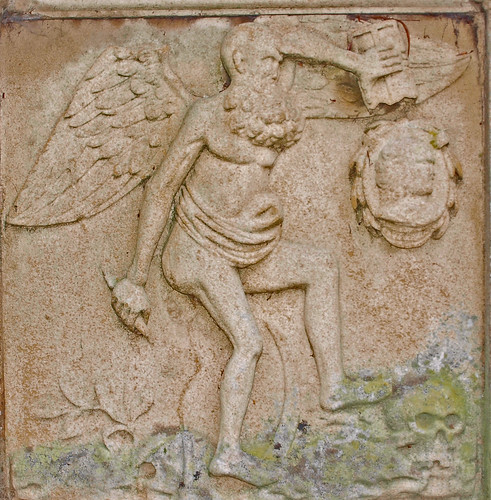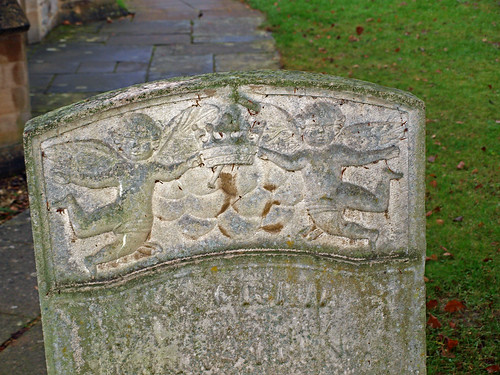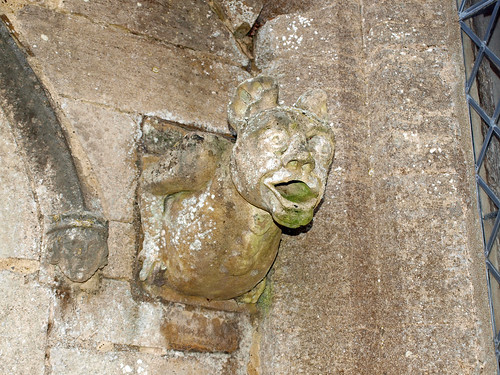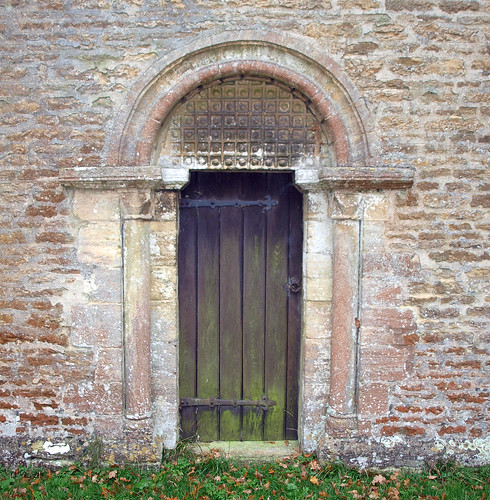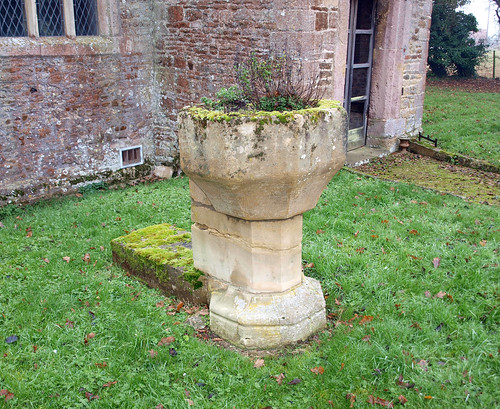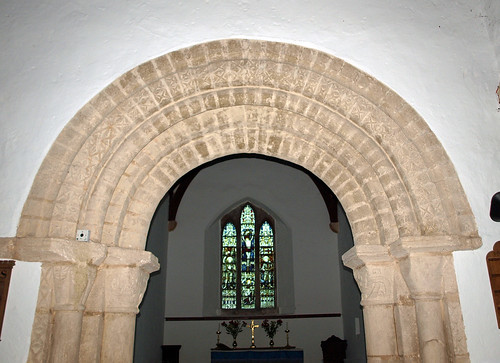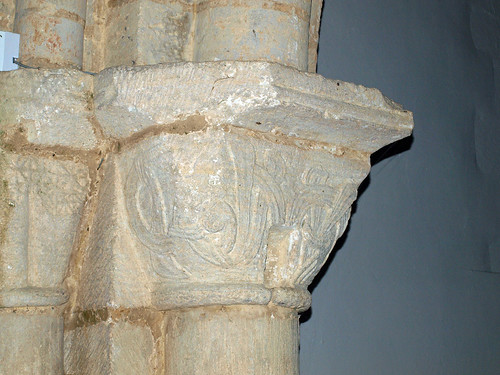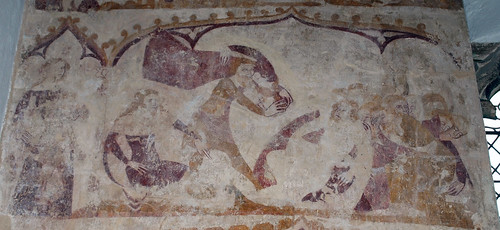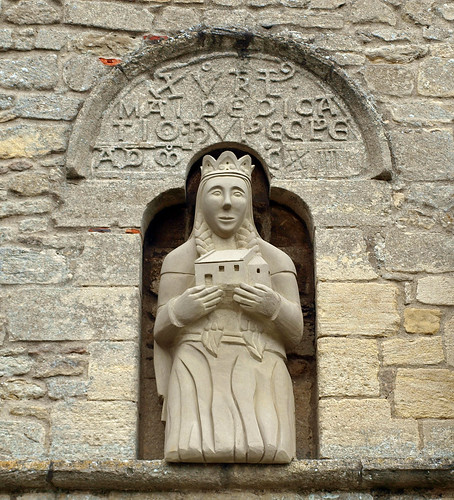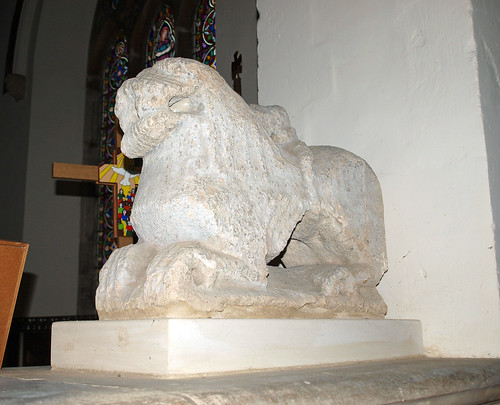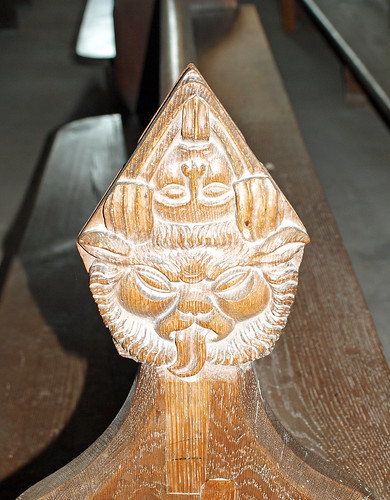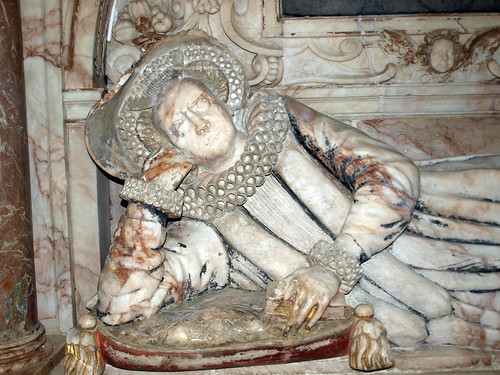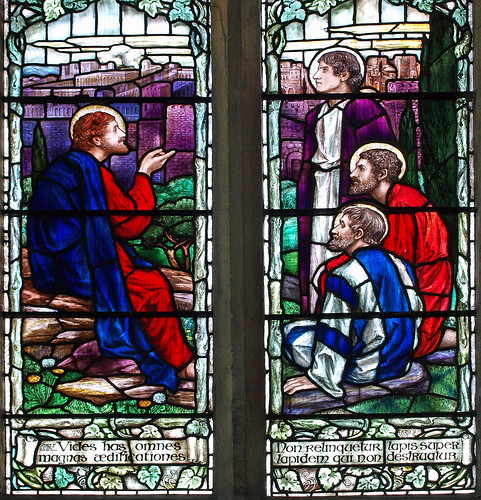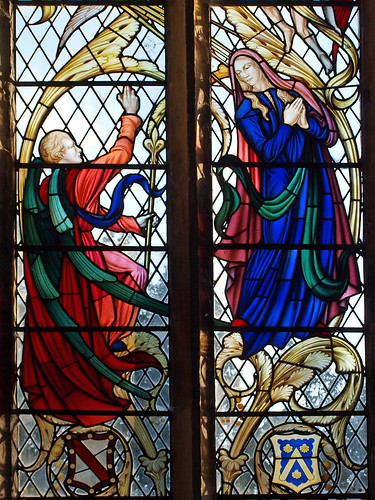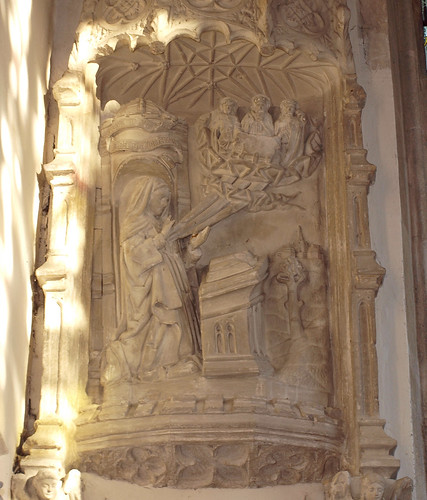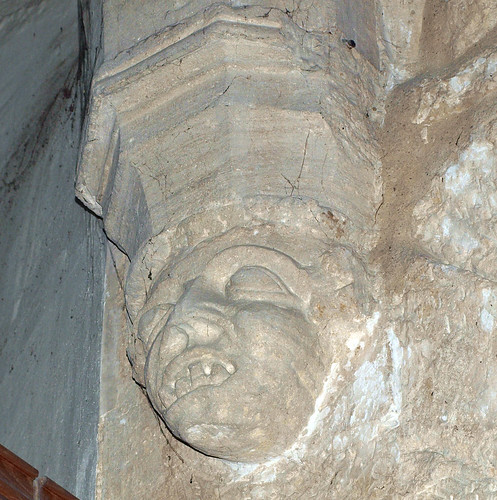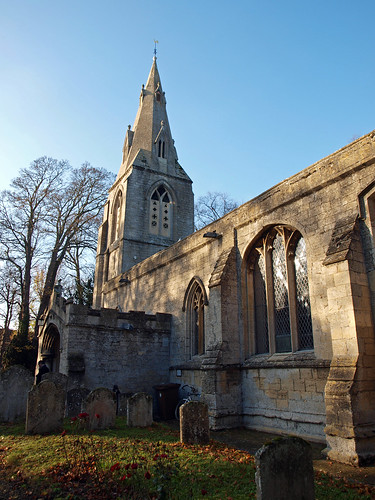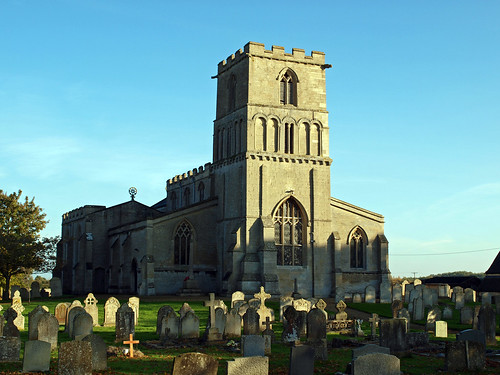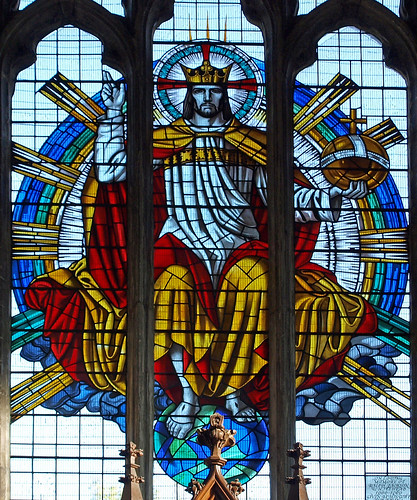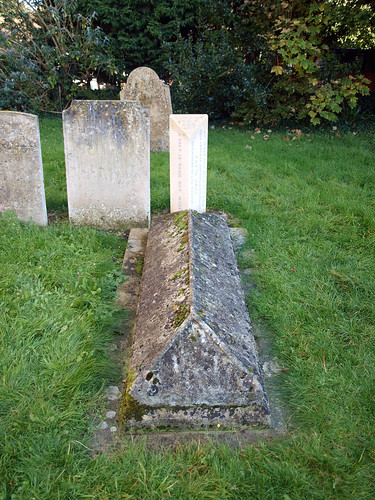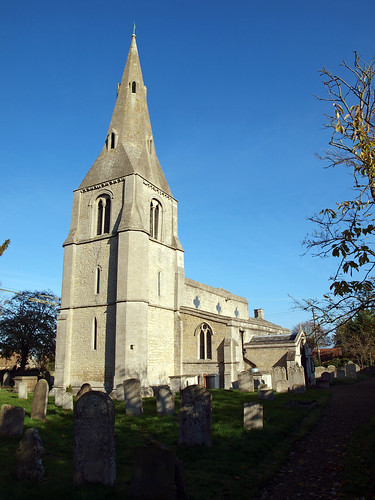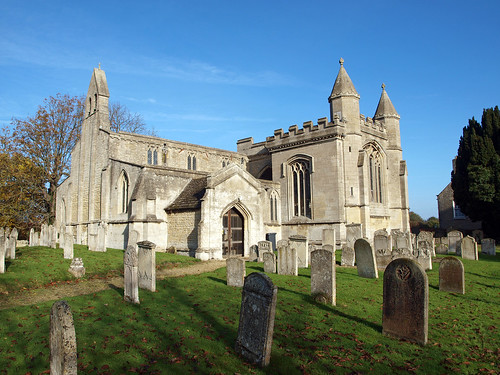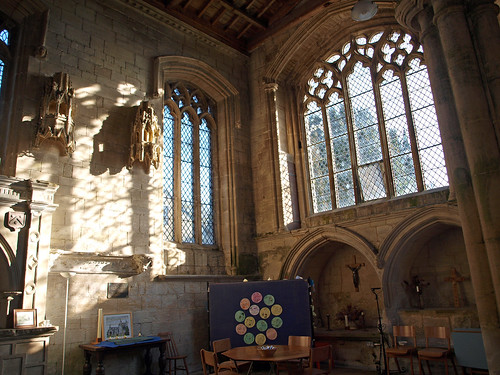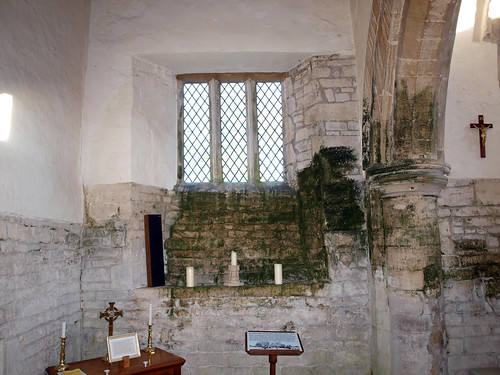St Andrew, locked keyholders listed, is probably, no..definitely, the strangest exterior I've come across to date [it's my 1096th church so it's taken a while to get to this level of weird]; a somewhat mundane C12/13 nave and chancel are made extraordinary by the addition of a massive south transept, part of an expansion plan by an unknown Delamare which was then derailed for unknown reasons, probably lack of money looking at the scale of building, resulting in a, being generous, half built extension which appears to make the church leak like a sieve. It's bonkers and naturally I loved it.
ST ANDREW. The general impression is more curious than beautiful - a small church like many others in the neighbourhood and the fragment of an enlargement so bold that it would have given Northborough one of the biggest parish churches in the county. The original building is late C12 to C13. Late C12 the W end with the bellcote. Four thin buttresses, two open bell arches with continuous roll mouldings, and a gable. C13 the s doorway (orders of colonnettes, moulded arch with very wilful details, a little stiff-leaf and two head-stops), the S and N aisle windows, the arcades inside (three bays, circular piers, circular capitals and abaci, double-chamfered arches), and the SEDILIA and PISCINA in the S aisle. The chancel is Dec - see the chancel arch with fillets on the responds and knobbly leaves on one capital - and the N and S windows. Dec also the start of the great renewal. The work was paid for by a member or members of the Delamare family. In the new S transept end wall, two large tomb recesses are provided, and as the effigies have disappeared (cf. however Glinton) one cannot now say which of the Delamares was the benefactor. Geoffrey died in 1327, Henry in 1340. The transept is two big bays long and ends in a wall with a big five-light window between two polygonal turrets. The window has flowing tracery of original design under a four-centred arch. The E and W windows are equally interesting. They have segmental arches, and the tracery beneath them is of arch heads standing on the apexes of the arches of the lights. The arch heads are filled with minor tracery motifs. The transept is embattled and has a frieze of ballflower below the parapet. The W wall is obviously not in its final form. To the N of the window it recedes, and there is an arch there rising only partly above the roof of the old aisle. This arch must be intended to be the connexion between the new work and a new, much higher aisle, i.e. a completely new W arm.
In the interior the incompleteness is even more noticeable. Arch into the chancel with continuous mouldings (two waves). Another, much too high, into the aisle. But as the transept W wall lies a little further to the W, this arch rests on a detached pier, and thus a narrow passage is formed between the main vessel of the projecting part of the transept and its W wall. The pier is slender and has a square core with four demi-shafts. Moulded capitals, arch mouldings as in the other arches. At the S end the arch stands on a small horizontal human figure. The window is shafted inside, the other windows have head-stops. In the E Wall between the two windows, and originally no doubt above the altar, two brackets for statues and two rich canopies. The two tomb recesses have already been mentioned. The work is lavish throughout and done in excellent masonry. - PLATE. Cup and Cover Paten, 1776. - MONUMENT. James Claypole d. 1594. Big, rather bare standing monument with a plain arch. No effigy. The Claypoles owned Northborough Manor House. Cromwell’s daughter married a Claypole. His widow also lived at Northborough.
NORTHBOROUGH. A pleasant village of grey stone houses, with a wealth of trees and cottages standing in their own gardens, a village in which Fame has called at the cottage as well as the manor. Northborough lies seven miles across the Fenlands from the stately cathedral of Peterborough. It is a village to come to for its own sake, but if it had no natural charm the pilgrims still would come, for here lie two widows, Mrs Oliver Cromwell and Mrs John Clare.
Cromwell’s widow came here after the Restoration to spend the last years of her life with her son-in-law John Claypole, who had married Elizabeth, the fairest and best beloved of Cromwell’s daughters. He, too, was bereaved, for his wife had passed away less than a month before her father, and was laid to rest in the Abbey, the only Cromwell allowed to remain there when Charles the Second took his revenge by flinging the bones of Cromwell and Blake into the dust. The manor house of the Claypoles, now a farmhouse, is a stone-roofed group with a courtyard, a house of mellow stone, built in 1340, with a vaulted gatehouse and a dignified Tudor porch. Over the porch is a little room called Cromwell’s Closet, for it is said that Cromwell was often a visitor here, and there are those who believe that his body may have been laid in the churchyard. The theory is suggested by the existence of a document saying that the body was conveyed by night from London to “Narborough,” and it is said that a headless body was once seen at the opening of a grave here. But the evidence is against it, and it is generally accepted that Cromwell’s body rests at the house of his daughter Lady Fauconberg, Newburgh Priory in Yorkshire, walled up in what is known as Cromwell’s Room.
What is certain is that in this lovely manor house Cromwell’s widow lived through the evening of her life, and that they laid her to rest under the floor of the beautiful Claypole chapel.
John Clare’s widow was taken to the churchyard from the cottage in which she lived with the poet until his reason failed him, and he was taken away from here to live 22 years in a madhouse. Their cottage is still here, with its thatched roof, and in front of it grow Madonna lilies, a lovely feature of most cottage gardens here. The cottage was built for the poet, and he was able to arrange with the builder to face it away from the road so that he could pass through his front door into his secluded garden, and could hide, when visitors came, behind the thick yews which his boys cut so neatly into circles and cones. Often he would hide here while Patty was telling some fashionable caller that he had just gone out:.
Beyond the garden was the orchard, and beyond its willow boundary was the pasture. He had come here as a farmer, a rich patron having built the house for him, but was too poor to stock the farm, so that he had to let the pasture. One of his half-helpful friends in London bought him a cow, another sent him two pigs and five pounds for tools, but it was all of little avail, and muddle-headed John, who could get nothing much out of life except the poetry that came into his head, wrote that he quite agreed with Solomon that it was better to die than to be poor. He was under this roof for five years, having come from Helpston where he had been under the same roof for 40 years, and then his independent life was at an end.
We found his grandson, another John Clare, mowing the grass by the roadside a little way from the village, and he talked with us with simple dignity of the sad old age of the first John Clare who had written his poetry as he walked these roads and fields. He was never happy here, for he had been transplanted from his native soil. He had roses climbing up his porch, the lovely yews still growing in his garden, and delightful country around, but he had lost his home, and his fits of melancholy became ever more frequent as he voiced his loneliness and grief in his poems.
The church which shelters the figures of these two famous widows was begun in Norman days and bears the mark of builders of succeeding centuries. Of the Norman building all that remains is the west wall of the nave, a striking spectacle for it has neither doorway nor window, while above it is a double bellcot with little round Norman arches framing the two bells, one medieval and the other 17th century. Even more striking are the two eight-sided turrets, battlemented walls, and ballflower ornament of the 14th century south chapel.
The two aisles with their deeply splayed west windows, and the arcades on round pillars, come from the 13th century. In the north aisle is an aumbry and a recess with lovely window tracery at the back which may have served as an Easter Sepulchre. The south aisle, still with its original roof, has a beautiful doorway with columns and deep mouldings, and at the east end is a double arch which served as sedilia, and a trefoil-headed piscina long hidden by a wall of the chapel. The south porch and the clerestory, which also has its original roof, were added in the 15th century. The eight-sided font is also medieval, and the existence of ancient wall-paintings beneath the thick plaster is indicated by black letter inscriptions and other fragments of ornament on various parts of the wall and arcades. The chancel with its two piscinas is 14th century and the capitals of its wide arch have the distinctive natural foliage of this period.
A little later in the 14th century Geoffrey de la Mare built his splendid chantry, now called the Claypole Chapel. He set a great arch in the south wall of the chancel, and a loftier arch at right angles to this (leading into the south aisle) which forms part of the chapel arcade and is supported by a beautiful clustered column with a solemn face above. A tiny doorway here, in the corner, is the only clue to the existence of the turrets seen outside. One of these contains a stairway leading from the roof and down to a charnel house; two openings in the east wall outside belong to chutes through which for centuries gravediggers conveniently disposed of bones. In the other turret is a tiny room which was probably used by the chantry priest; one of them is said to have been found dead here sitting in his chair. We may pass through a doorway in one of these turrets and have the curious experience of walking along the windowsill of the great south window of the chapel, the little doorways opening in the columns forming the window jambs. Below the window are two exquisitely carved recesses which may once have held the altar tombs and figures of Geolfrey de la Mare and his wife, and a quaint head links the two arches. Between the windows in the east wall of the chapel are two beautiful canopies for sacred statues, canopies said to have been models for the stalls of Peterborough Cathedral.
Beneath the floor of this lovely chapel, somewhere near the centre (now encumbered by an organ tending to mar its graceful lines) lies Mrs Oliver Cromwell, buried here on November 19, 1665, year of the Great Plague. Near her lie two of her grandchildren, Martha and Cromwell Claypole, children of the Protector’s favourite daughter Elizabeth, who herself sleeps in Westminster Abbey. It is interesting to record that Cromwell Claypole in his will asked to be buried “as near my grandmother Cromwell as convenience will permit.” There is an arched recess in a ten-foot tomb of an Elizabethan James Claypole, but of other Claypoles the only legible stone is Martha’s, buried two years before her grandmother.
John Clare’s widow, Patty, lies in the churchyard, east of the chancel, and near her rest some of her children. Over a daughter’s grave is the poet’s Universal Epitaph, with the last line spoiled by the substitution of ‘ woman ’ for ‘ man ’:
No flattering praises daub my stone
My frailties and my faults to hide.
My faults and failings all are known
I lived in sin and in sin I died.
But oh condemn me not, I pray,
Ye who my sad confession view,
But ask your soul if it can say
That I’m a viler woman than you.
An unhappy epitaph, written by an unhappy man.
Mrs John Clare
IT was in the second autumn after Waterloo that Patty Turner met John Clare in the lanes at Great Casterton. He said he was John Clare and she said she was Martha Turner. They stopped in sight of a cottage with a barn, when Martha said this was her home and he must go. But John Clare came again and again, and always when Patty saw him she would run for her gingham frock. She had never known anyone who talked like this young man from the lime kilns, and he had actually written a poem about her, in which he said “My love, thou art a nosegay sweet.”
His Patty was so dear to him that for the first time in his life he made a serious effort to find some occupation away from the lime kilns. He would become a poet, and now Patty, whose father had forbidden their meetings, and who had been half in love with a cobbler, defied her father and gave up the cobbler and married the poet.
Alas, John muddled his life through. He wrote fine poems, hundreds of them, and his name will live in literature, but he could not control his life; we read at Helpston how he frittered it away.He was a nine-days-wonder in London, and footmen in livery would call at Patty’s cottage while he was working in the fields to give an invitation for John to visit this nobleman or that. Patty must have been a little tired of all this patronage while she was struggling to buy food and clothes for her growing family. She saw the children weakening for want of nourishment, and John’s health breaking down, and all his lovely verses were of little comfort to her now. Sickness, debts, and the constant nag of poverty were only a little relieved by the kindly help of a few faithful friends, and at last John’s mind gave way.
One terrible winter Patty’s seventh child came, and John Clare lost his reason. A friend took him away and Patty never saw him again, though he lived in a madhouse for 22 years. Her dreams, like his, had been broken. She, like him, had loved the sunshine and the flowers, but the drudgery of life, the long long gloom with rare brief patches of sunlight breaking through was too much for her. She bore the burden of his long and bitter life but could hardly have been said to share his rare hours of enchantment. She could not endure the misery of going to see him in Northampton Asylum, and she lived on after him and was carried to her grave in Northborough churchyard, a grave unmarked and now forgotten.
Mrs Oliver Cromwell
THE simple woman who was to share the life of Oliver Cromwell was the daughter of a knight of Essex, Sir James Bourchier, and was married to Cromwell when he was only 21. The marriage took place at the altar of St Giles’s in Cripplegate, where long afterwards they were to bring an old man named John Milton for his long rest.
Cromwell was at that time a country gentleman of moderate fortune, and it was a comfortable home to which he took his bride, and there were born to them four girls and four boys. When the Civil War broke out, and Cromwell, who had never had a day’s military training, became a leader of the Parliamentary forces, Elizabeth was left to watch over the safety of the children, and of Oliver’s aged mother, while he was fighting the country’s battles. In the end, when Cromwell became Protector, king in all but name, Elizabeth remained the same modest woman who had ruled over his house in Huntingdon.
When he was away she would write him homely letters, playfully begging him not to forget her and the children, and it was one of these letters that Cromwell, who used to write to her at every opportunity, sat down to answer after his great victory at Dunbar:
My dearest, I have not leisure to write much. But I could chide thee that in many of thy letters thou writest that I should not be unmindful of thee and thy little ones. Truly, if I love thee not too well, I think I err not on the other hand. Thou art dearer to me than any other creature.
Again in the following year we find him writing:
My dearest, I could not satisfy myself to miss this post, although I have not much to write; yet indeed I Iove to write to my Dear, who is very much in my heart.
That is charmingly said, after thirty years of married life; but Elizabeth also had her difficult times, for Cromwell was given to fits of melancholy and lasting sadness, and it was her part to comfort him.
She came very near to being Queen of England, but was saved from that false step by the tough old warriors of an unconquerable army, who, while they loved Cromwell and would have died for him, would not tolerate the idea of another king. Parliament voted him £100,000 a year and two palaces, Whitehall and Hampton Court, but the life of the Cromwells was very simple and their food was as plain in their great days as when they were plain country folk.
When Oliver died, Elizabeth, like all the Cromwells, fell on evil days. Within two generations Cromwells were begging their bread. Scandal mongers spread abroad abusive reports of Mrs Cromwell, now living in quiet poverty, saying she had stolen things belonging to the royal house, and gangs of ruffians visited her house repeatedly, pretending to search for the king’s property but themselves stealing her small possessions. She bore it for a while, then wrote to the king affirming her innocence and begging for his protection. Her appeal was ignored, the letter being casually put away with the king’s papers, marked “The petition of Old Noll’s wife ”; so Cromwell’s widow crept away from London, and no one knows where she hid till at last she found refuge at her son-in-law’s farm at Northborough. Here she died on November 19, 1665. Had she died ten years before she would have had a national funeral in Westminster Abbey; as it was the woman who had been so near the throne passed away unnoticed, and was laid to rest in a simple grave.
Flickr.
